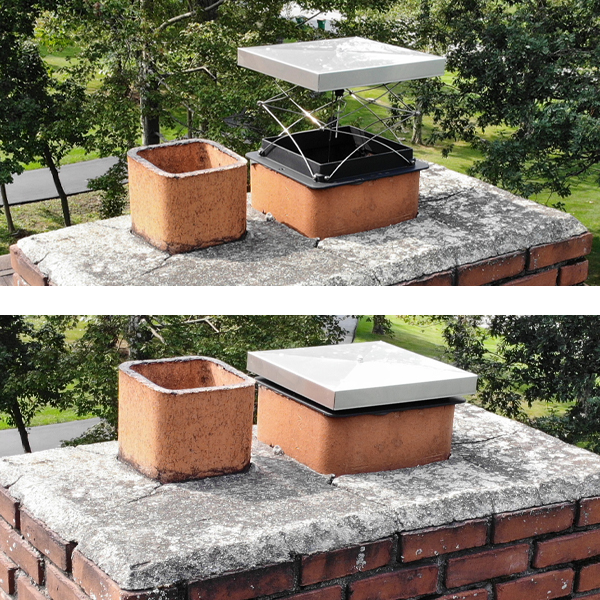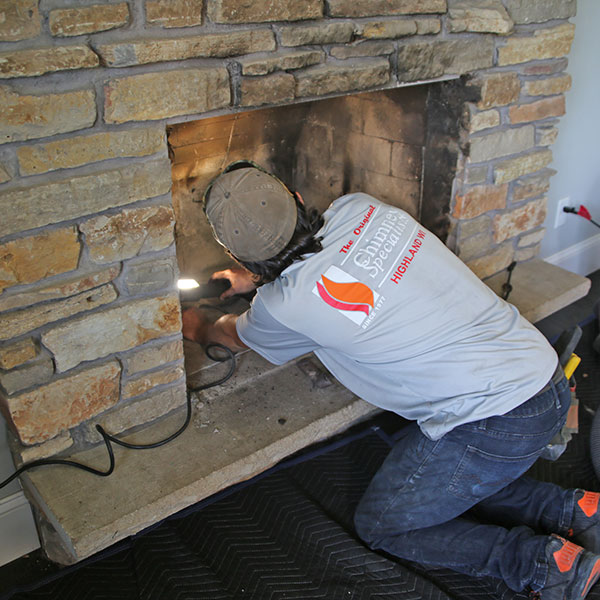What’s a Chimney Damper?
People with fireplaces often wonder, what is a chimney damper? Maybe that’s because it’s a hidden component of the chimney system. Another common question homeowners ask chimney sweeps is, are chimney dampers necessary? These are great questions! You can operate your fireplace more efficiently when you know about the different parts of the chimney system. Chimney dampers serve good purposes, and commonsense makes them a necessity. Read on to get acquainted with chimney dampers and their purpose.
 What is a Chimney Damper?
What is a Chimney Damper?
A chimney damper is a flap or door that is manually opened and closed to control airflow inside the chimney. Open the damper before lighting a fire to ensure that combustion fumes go up and outside through the chimney and not into your home.
Close the damper once the fire has gone cold to prevent the heated air in your home from escaping through the chimney. An open damper is like a wide-open window that causes heating and cooling costs to skyrocket.
What are the Different Types of Chimney Dampers?
There are two basic types of chimney dampers, and they are throat dampers and top-sealing dampers. Details follow, including the pros and cons of each type.
Throat Damper
Traditional dampers are in the throat of the chimney, which is just above the fireplace. A throat damper consists of a steel or cast-iron plate or set of flaps. The damper is supposed to seal when closed so that air can’t leak through. The operation of a throat damper depends on whether its style is a poker, pivot, or rotary-operated damper. All types are manually operated.
Pros: Creosote removal is easier to accomplish with a throat damper because top-mount dampers interfere with the ability to perform the work. Using a chimney brush is only sufficient to remove one type of creosote. There are two other forms of creosote, and each requires the use of special equipment to remove the tar-like, highly flammable substance.
Cons: Throat dampers are prone to warp, which prevents them from sealing when closed. Replacing a damaged throat damper is often cost-prohibitive, requiring significant masonry work.
Top-Sealing Damper
Top-sealing dampers are also known as top-mounted or chimney cap dampers. These dampers are located at the top of the chimney. Top-sealing dampers feature a spring-loaded door at the top of the chimney. A steel cable or chain runs from the steel door at the chimney top-down through the chimney flue to a lever or latch above the firebox.
Pros: Top-mount dampers are easier to operate than throat dampers. A money-saving benefit of a chimney top damper is that it helps to cut the costs of cooling and heating. A chimney cap damper prevents cold air from filling the chimney flue in winter. In the summertime, it helps keep warm air out of the house. As an added plus, a top-sealing damper prevents animals and other debris from getting inside your chimney, making a mess, causing an obstruction in the flue, and possibly creating bad odors.
Cons: Up-front costs of a top-mount damper are more expensive than a throat damper. The money you save from the various benefits makes a top-mount damper a cost-cutter in the long run. A caveat with top-mount dampers is that they can be installed in masonry chimneys with traditional open fireplaces only. Top-mount dampers cannot be installed if you have a prefab fireplace, free-standing stove, or a gas log set.
 Contact Dubuque Fireplace & Patio for Chimney Damper Installation
Contact Dubuque Fireplace & Patio for Chimney Damper Installation
The NFI-certified technicians at Dubuque Fireplace & Patio provide comprehensive chimney and fireplace services.
We are glad to answer questions such as what is the purpose of a chimney damper and why is it necessary?
Visit us today at 925 Century Drive in Dubuque, contact us online, or call us at 563.582.5156 today.


 (563) 582-5156
(563) 582-5156


